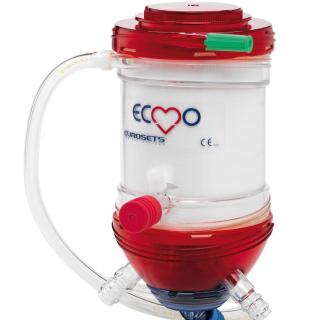
介绍:
Extracorporeal Membrane Oxygenation (ECMO)
体外膜肺氧合(ECMO)
【overview】
ECMO stands for extracorporeal membrane oxygenation. The ECMO machine is similar to the heart-lung by-pass machine used in open-heart surgery. It pumps and oxygenates a patient's blood outside the body, allowing the heart and lungs to rest. When you are connected to an ECMO, blood flows through tubing to an artificial lung in the machine that adds oxygen and takes out carbon dioxide; then the blood is warmed to body temperature and pumped back into your body.
ECMO指体外膜肺氧合。ECMO机器类似于心脏手术中使用的心肺旁路机,它在体外将患者的血液氧合后再回泵,使心肺得到休息。当人体连接到ECMO时,血液通过管道流入人工肺,在此过程中补充氧气并排出二氧化碳,接着血液被加热至体温,再泵回人体。
There are two types of ECMO. The VA ECMO is connected to both a vein and an artery and is used when there are problems with both the heart and lungs. The VV ECMO is connected to one or more veins, usually near the heart, and is used when the problem is only in the lungs.
ECMO有两种类型。VA-ECMO连接动静脉,用于心肺联合替代;VV-ECMO连接一至多条静脉,通常是靠近心脏的静脉,用于单纯肺功能受损。
UCSF is also now using a smaller portable ECMO device that is light enough to be carried by one person and can be transported in an ambulance or helicopter, making it possible to provide ECMO relief in emergency cases.
美国加州大学旧金山分校(University of California at San Francisco,UCSF)现在也使用一种可单人操作的小型便携式ECMO设备,并可用救护车或直升机运送,使得紧急情况下提供ECMO救助成为可能。
Machines designed to provide extracorporeal membrane oxygenation (ECMO) have been in use since the early 1970s—and are often associated with newborns in respiratory distress. But in an effort to save more lives, UCSF physicians have begun using the technology earlier and with a broader range of patients than in the past. What distinguishes the use of ECMO at UCSF is the patients we select and the point at which we choose to use it.
提供体外膜肺氧合(ECMO)的机器自1970年代初就开始投入使用,常与新生儿呼吸窘迫相关。但是为了拯救更多的生命,UCSF的医生比过去更早且更广泛应用这项技术。UCSF使用ECMO的不同之处在于选择何种患者和选择何时开始。
When is ECMO used:
For patients recovering from heart failure, or lung failure or heart surgery.
As a bridge option to further treatment, when doctors want to assess the state of other organs such as the kidneys or brain before performing heart or lung surgery.
For support during high-risk procedures in the cardiac catheterization lab.
As a bridge to a heart assist device, such as left ventricular assist device (LVAD).
As a bridge for patients awaiting lung transplant. The ECMO helps keep tissues well oxygenated, which makes the patient a better candidate for transplant.
何时使用ECMO:
用于心脏衰竭、肺功能衰竭或接受心脏外科手术的患者。
当医生们希望在进行心肺手术之前评估其他器官,如肾脏或大脑的状态时,可作为进一步治疗的桥接选择。
在心脏导管室的高危操作过程中给予支持。
作为心脏辅助装置的桥接,如左心室辅助装置(LVAD)。
作为等待肺移植患者的桥接措施。ECMO能保持组织较好氧合,使患者更适合接受移植。
【Procedure】
Being placed on ECMO requires a surgical procedure but it is usually done in a patient's room. The patient is sedated and given pain medication and an anti-coagulant to minimize blood clotting. A surgeon, assisted by an operating room team, inserts the ECMO catheters into either an artery or veins. An x-ray is then taken to ensure the tubes are in the right place. Usually a patient on the ECMO pump will also be on a ventilator, which helps the lungs to heal. While on ECMO, the patient will be monitored by specially trained nurses and respiratory therapists, as well as the surgeon and surgical team. Since you will be sedated and have a breathing tube in place, supplemental nutrition will be provided either intravenously or though a nasal-gastric tube. 【过程】
放置ECMO需要手术,但通常是在病房进行。病人服用镇静剂、止痛药和抗凝剂以减少血液凝固。外科医生在手术室团队协助下,将ECMO导管插入动脉或静脉。然后拍x光片以确保管子放置在正确的位置。通常情况下,使用ECMO的患者也会使用呼吸机,这有助于肺部恢复,在这过程中,病人将由受过专门训练的护士和呼吸治疗师共同监护,此外还有外科手术团队。由于病人将被麻醉,并且放置呼吸管,营养将通过静脉或鼻胃管进行补充。
While on ECMO, you may be given certain medications including: heparin to prevent blood clots; antibiotics to prevent infections; sedatives to minimize movement and improve sleep; diuretics to help the kidney get rid of fluids; electrolytes to maintain the proper balance of salts and sugars; and blood products to replace blood loss. Discontinuing ECMO requires a surgical procedure to remove the tubes. Multiple tests are usually done prior to the discontinuation of ECMO therapy to confirm that your heart and lungs are ready. Once the ECMO cannulas are removed, the vessels will need to be repaired. This can be done either at the bedside or in the operating room. The doctor will use small stitches to close the spot where the tubes were placed. You will be asleep and monitored for this process. Even though you are off the ECMO, you may still need to be on a ventilator.
上了ECMO之后,患者可能会被给予某些药物,包括:肝素用来预防血栓;抗生素用来预防感染;镇静剂用来减少活动、改善睡眠;利尿剂用来帮助肾脏排出液体;电解质用来维持盐和糖的平衡;血液制品补充失血。终止ECMO需要通过手术移除插管。在停止ECMO治疗之前,通常会进行多次测试,以确保心脏和肺已经准备充分。一旦ECMO管被拔除,血管则需修复,此时医生将用小针缝合置换部位。在这过程中,患者将处于睡眠状态,并被全程监护。这些可在床边或者手术室里完成。即使患者撤离了ECMO,仍然需要依靠呼吸机维持一段时间。
Risks
ECMO does carry risks including:
Bleeding, due to the medication that's given to prevent blood from clotting in the tubing.
Infection at the sites where the tubes enter the body.
Transfusion problems, since a person on ECMO is given blood products.
Small clots or air bubbles forming in the tubing.
Increased chance of stroke.
【风险】
ECMO存在的风险包括:
由抗凝剂引起的出血。
置管部位出现感染。
由于输注血液制品而出现的输血问题。
管内形成的小凝块或气泡。
中风的几率增加。
【language points】
1.sedate /sɪˈdeɪt/adj.安静的;镇静的;
vt.使镇静;给…服镇静剂
Sedative/ˈsedətɪv/ n.镇静剂,止痛药
adj.镇静的,镇定的,止痛的;
sedation /sɪˈdeɪʃn/ n.(尤指服用镇静剂而进入的)休息状态,睡眠状态;
2.anti-coagulant 抗凝剂
Anti-前缀,“抗” eg. Antibody抗体
Coagulation 凝固
3.antibiotics /ˌæntɪbaɪ'ɒtɪks/n.抗生素
Bio-(life,living) eg.Biopsy 活检
4.Diuretic /ˌdaɪjuˈretɪk/ n.利尿剂
Ur/o-;urino-(urine) eg.uremia /jʊ'ri:mɪə/尿毒症
5.Minimize最小化
Maximize最大化
6.Ventilator/ˈventɪleɪtə(r)/ 呼吸机
7.respiratory therapists 呼吸治疗师
8.nasal-gastric tube鼻胃管
Nas/o-(nose) eg. Nasal/ˈneɪzl/ cavity 鼻腔
Gastr/o-(stomach)eg.Gastric/ˈgæstrɪk/ 胃的
gastrointestinal(GI)胃肠的
9.Heparin/'hepərɪn/肝素
Hepat/o-(liver) eg.Hepatitis 肝炎
-in,-ins(a substance)eg.Insulin 胰岛素
10.Electrolyte/ɪˈlektrəlaɪt/ n.电解质
11.Discontinuing终止
12.Stitch/stɪtʃ/ n.针 vt.缝
(英文资料来源:cardiac.surgery.ucsf.edu;中文为讲者自译,图片来源于网络。)
Bgm-keep holding on
撰稿讲解:福建医科大学 淑铉铉铉
大家还在听

